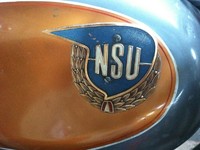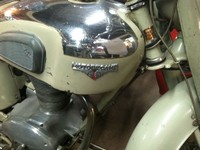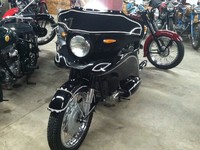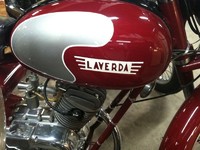 How can you tell the location of a rich cache of vintage iron? Is it a multiple-bay garage on the well-manicured property? Multiple out-buildings in a bucolic setting out in the country? A chic architectural museum in the city? Some guy’s basement? The answer of course is yes. What if the place has the word museum attached to it? My experience indicates that this makes no difference. However, one place that you should be sure to look at these days is in the warehouse district of your town/city. That is where you will find places previously mentioned like the Simeone Museum (see Simeone Classic Motorcycles), and that is where I found the Vintage Motos Museum.
How can you tell the location of a rich cache of vintage iron? Is it a multiple-bay garage on the well-manicured property? Multiple out-buildings in a bucolic setting out in the country? A chic architectural museum in the city? Some guy’s basement? The answer of course is yes. What if the place has the word museum attached to it? My experience indicates that this makes no difference. However, one place that you should be sure to look at these days is in the warehouse district of your town/city. That is where you will find places previously mentioned like the Simeone Museum (see Simeone Classic Motorcycles), and that is where I found the Vintage Motos Museum.
 Vintage Motos is located in a warehouse district in downtown Denver. The area is a mixture of functioning warehouses, some warehouses converted to business condos, and quite a few just abandoned. Vintage Moto is in a typical older nondescript brick building. When I arrived, I walked in to find a small business on the ground floor. They directed me to the side of the building where the was a small sign above a metal grate door leading to the basement. Through the door is a narrow stairway leading down to the museum. Once you emerge from the dimly lit stairwell, you emerge into a sea of vintage motorcycles that is a veritable assault on the senses. You are just not prepared for it, and if you have MADHD (Moto-induced ADHD), you may need to consult your doctor before visiting this place. If you are an Italian vintage motorcycle enthusiast, take a double dose of some heart palpitation meds.
Vintage Motos is located in a warehouse district in downtown Denver. The area is a mixture of functioning warehouses, some warehouses converted to business condos, and quite a few just abandoned. Vintage Moto is in a typical older nondescript brick building. When I arrived, I walked in to find a small business on the ground floor. They directed me to the side of the building where the was a small sign above a metal grate door leading to the basement. Through the door is a narrow stairway leading down to the museum. Once you emerge from the dimly lit stairwell, you emerge into a sea of vintage motorcycles that is a veritable assault on the senses. You are just not prepared for it, and if you have MADHD (Moto-induced ADHD), you may need to consult your doctor before visiting this place. If you are an Italian vintage motorcycle enthusiast, take a double dose of some heart palpitation meds.
 Vintage Motos is based upon the collection of Jim Dillard, and his son James. Motorcycles grew from hobby to obsession, and they have thankfully decided to share that obsession with the rest of us. At the time of my visit, Jim had just passed away, but the museum was open anyway, consistent with what Jim would have wanted according to John. I was sorry that I narrowly missed meeting the man, but the collection provides a lot of insight. Somewhere around 200 bikes are displayed in an L-shaped space. It is very densely populated but in no way claustrophobic. I was the only visitor at the time, which was shocking given the richness of the collection, but perfect for taking your time through narrow aisles. On my visit, the first motorcycles you see were a museum-quality restoration of a 1963 Parilla Wildcat scrambler, and a Ducati TV 125. Both are rare and beautifully done. The Parilla in particular was a four-year restoration effort according to John Frost at the museum. The contents of the museum are predominantly Italian vintage bikes, but not exclusively. I was pleasantly surprised to find several NSU’s, a couple of BMWs, and a few Adlers. One blue Adler, in particular, occupied a place of prominence in the small lounge area. The beautiful R60 BMW on display also had both the upper and lower Wixom fairing rarely seen installed. There are also several British bikes like a nice Velocette and an Ariel Red Hunter, a wonderful Austrian 1938 Puch, and a few Japanese bikes.
Vintage Motos is based upon the collection of Jim Dillard, and his son James. Motorcycles grew from hobby to obsession, and they have thankfully decided to share that obsession with the rest of us. At the time of my visit, Jim had just passed away, but the museum was open anyway, consistent with what Jim would have wanted according to John. I was sorry that I narrowly missed meeting the man, but the collection provides a lot of insight. Somewhere around 200 bikes are displayed in an L-shaped space. It is very densely populated but in no way claustrophobic. I was the only visitor at the time, which was shocking given the richness of the collection, but perfect for taking your time through narrow aisles. On my visit, the first motorcycles you see were a museum-quality restoration of a 1963 Parilla Wildcat scrambler, and a Ducati TV 125. Both are rare and beautifully done. The Parilla in particular was a four-year restoration effort according to John Frost at the museum. The contents of the museum are predominantly Italian vintage bikes, but not exclusively. I was pleasantly surprised to find several NSU’s, a couple of BMWs, and a few Adlers. One blue Adler, in particular, occupied a place of prominence in the small lounge area. The beautiful R60 BMW on display also had both the upper and lower Wixom fairing rarely seen installed. There are also several British bikes like a nice Velocette and an Ariel Red Hunter, a wonderful Austrian 1938 Puch, and a few Japanese bikes.
 However, Italian motorcycles are clearly the focus, and the period between 1940 and 1980 is the time span. I saw many brands that I had never before encountered outside of books, or at all. And, there were multiple examples of all of them. Ever seen a Ceccato or a Ferrari or a Ganna motorcycle? How about a Fiorelli or a Moto Torpado? These are just a few of the many brands represented in the museum. Some with faded logos are difficult to read, many are just very nice examples, and many more are restored examples. It is a history of Italian motorcycles over 4 decades, and you can see the evolution from postwar to the growth of the many small-bore marques, to the celebrated exotic superbikes. There is a startling variety of engineering and design in the museum. Pushrod, bevel gears, unit construction, cylinder layout, etc are all varied across time and across marques. Between variation and the closely packed motorcycles, there was no way to adequately capture the museum short of a book or a documentary. In the end, I settled on the tanks and the logos. They are as indicative of the rich variety present as anything else.
However, Italian motorcycles are clearly the focus, and the period between 1940 and 1980 is the time span. I saw many brands that I had never before encountered outside of books, or at all. And, there were multiple examples of all of them. Ever seen a Ceccato or a Ferrari or a Ganna motorcycle? How about a Fiorelli or a Moto Torpado? These are just a few of the many brands represented in the museum. Some with faded logos are difficult to read, many are just very nice examples, and many more are restored examples. It is a history of Italian motorcycles over 4 decades, and you can see the evolution from postwar to the growth of the many small-bore marques, to the celebrated exotic superbikes. There is a startling variety of engineering and design in the museum. Pushrod, bevel gears, unit construction, cylinder layout, etc are all varied across time and across marques. Between variation and the closely packed motorcycles, there was no way to adequately capture the museum short of a book or a documentary. In the end, I settled on the tanks and the logos. They are as indicative of the rich variety present as anything else.
The Vintage Moto Museum is the kind of place where I could spend an entire day. Without lunch. You cannot fully do it justice in words and pictures, you have to go in person. It is a physically hidden treasure, but it should be on the must-see list of any vintage motorcycle enthusiast who gets anywhere near Denver. For all of us looking for secret stores of vintage iron, don’t just look in the warehouse district, look in the basements of the warehouse district. And thank you, Jim Dillard.
Sounds like a great place. My favorite though is Barber in birmingham. You need 2 days to get it all in.
Cool place. Who wudda thought Denver? Never can tell….
Gary
Place looks cool… Great i really love it. The bikes are great.
For components of cars, OBDII Code-readers equipment will appropriately help you within a process can occasionally be quite strenuous. If you are like many who are tired of on the way to some garage for getting informed they contact for this or that, which all expenses the earth, and so are completely unnecessary for them to purchase or use, you contact for just about any change. The Auto Diagnostic tools can only be done by you, as well as you only. There could possibly be considered a effortless response that will solve all of your queries and scenarios you Fly scanner. research on on this short article to decide especially how you can uncover every one of the automotive means and OBD2 means units that will advantage you for the needs.
Nice post. I read your post and i like it. You really give your valuable information and link. Thank you for sharing…………….
Kawasaki ZX-12R Fairings
I didn't see this museum even if I have visited a similar structure in Italy: the Nicolis Museum, in the province of Verona .. a large container of cars and motorcycles, airplanes, and more .. however, the bike that made me more mad is the Norton Manx 500 .. http://www.museonicolis.com/en/doc-s-33-264-1-norton_manx_500.aspx